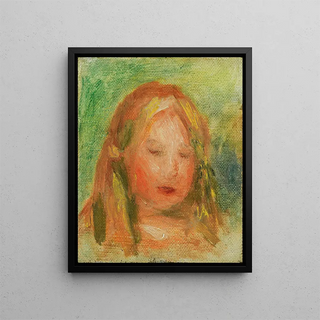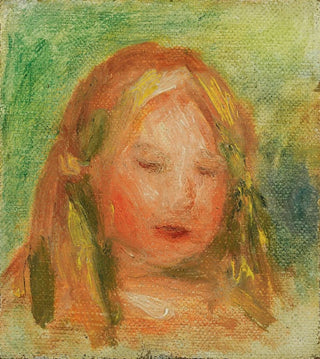Art print | Study of a Child's Head - Pierre-Auguste Renoir


View from behind

Frame (optional)
Pierre-Auguste Renoir’s “Study of a Child’s Head” embodies the essence of Impressionist art, where light and color blend to bring faces filled with tenderness and innocence to life. This study, created during a period when art sought new avenues of expression, reveals not only Renoir’s undeniable talent but also his ability to capture the very soul of childhood. Through this portrait, the artist invites us to immerse ourselves in a universe where simplicity of features and the brilliance of colors combine to evoke a profound emotion. The art print of this work is an invitation to explore the fleeting beauty of childhood, a theme dear to Renoir, who masterfully immortalized moments of life with rare sensitivity.
Style and uniqueness of the work
In "Study of a Child’s Head," Renoir deploys a characteristic style that sets him apart from his contemporaries. The brushstrokes, both fluid and vibrant, demonstrate an exceptional mastery of color. The chosen palette, rich in nuances, evokes natural light and creates a warm atmosphere. The delicate features of the child's face, accentuated by light shadows, give the latter a serene yet lively expression. This piece stands out for its intimate approach, where the gaze of the child seems to capture the observer, establishing a silent dialogue between the subject and the viewer. This interaction reflects an artistic vision that favors emotion over rigid representation, an emblematic characteristic of the Impressionist movement.
The artist and his influence
Pierre-Auguste Renoir, an iconic figure of Impressionism, successfully imposed his artistic vision during a time when academic conventions dominated the art scene. Born in 1841, he evolved in an environment where art was often perceived as a simple reflection of reality. However, Renoir chose to transcend this approach by emphasizing light, color, and emotion. His influence is undeniable, not only on his contemporaries but also on future generations of artists. By integrating

Matte finish

View from behind

Frame (optional)
Pierre-Auguste Renoir’s “Study of a Child’s Head” embodies the essence of Impressionist art, where light and color blend to bring faces filled with tenderness and innocence to life. This study, created during a period when art sought new avenues of expression, reveals not only Renoir’s undeniable talent but also his ability to capture the very soul of childhood. Through this portrait, the artist invites us to immerse ourselves in a universe where simplicity of features and the brilliance of colors combine to evoke a profound emotion. The art print of this work is an invitation to explore the fleeting beauty of childhood, a theme dear to Renoir, who masterfully immortalized moments of life with rare sensitivity.
Style and uniqueness of the work
In "Study of a Child’s Head," Renoir deploys a characteristic style that sets him apart from his contemporaries. The brushstrokes, both fluid and vibrant, demonstrate an exceptional mastery of color. The chosen palette, rich in nuances, evokes natural light and creates a warm atmosphere. The delicate features of the child's face, accentuated by light shadows, give the latter a serene yet lively expression. This piece stands out for its intimate approach, where the gaze of the child seems to capture the observer, establishing a silent dialogue between the subject and the viewer. This interaction reflects an artistic vision that favors emotion over rigid representation, an emblematic characteristic of the Impressionist movement.
The artist and his influence
Pierre-Auguste Renoir, an iconic figure of Impressionism, successfully imposed his artistic vision during a time when academic conventions dominated the art scene. Born in 1841, he evolved in an environment where art was often perceived as a simple reflection of reality. However, Renoir chose to transcend this approach by emphasizing light, color, and emotion. His influence is undeniable, not only on his contemporaries but also on future generations of artists. By integrating






